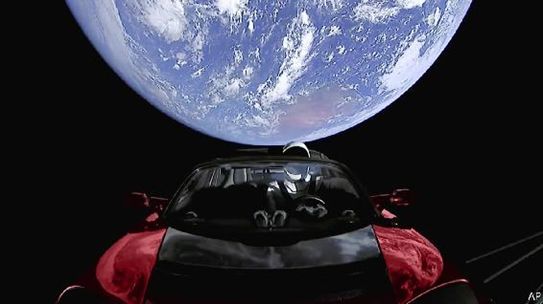The Falcon Heavy’s creator is trying to change more world than one
Failure is most definitely an option
Feb 8th 2018 | FREMONT AND SPARKS
IT WAS not, in the end, the much anticipated take-off that took your breath away. It was the landings. Eight minutes after they had lifted the first SpaceX Falcon Heavy off its pad at Cape Canaveral on February 6th, two of its three boosters returned. Preceded by the flames of their rockets, followed by their sonic booms, the slender towers touched down on neighbouring landing pads a fraction of a second apart. After such power, such delicacy.
Up above the atmosphere, the rocket’s second stage opened its fairing to reveal its cargo: a red roadster made by Tesla, a company which, like SpaceX, is run by Elon Musk. The dummy sitting at its wheel wore a SpaceX spacesuit, David Bowie played on the stereo, the motto from “The Hitchhiker’s Guide to the Galaxy”—“Don’t panic!”—was displayed proudly on the dashboard. In the background, the great blue disk of the Earth receded. Down below, a million geeks swooned.
Space X的发射不是最精彩的,最让人期待的,而是它的发射器着陆回地球是最精彩的
Topping off an extraordinary technical achievement with flamboyance and a touch of silliness is typical of Mr Musk. It should not be mistaken for a lack of seriousness. Mr Musk does not simply want to have fun building rockets and fast cars. Nor is he running two multi-billion-dollar companies just to become rich, or to beat rivals. He wants to open up fundamental opportunities with which he thinks the market would not trouble itself. The purpose of SpaceX is to make humanity an interplanetary species, and thus safe from global catastrophe, by providing it with the means to build a civilisation on Mars. The purpose of Tesla, emblazoned on the wall of its factory in Fremont, California, is: “To accelerate the world’s transition to sustainable energy”.
Creating either of these companies would be a signal achievement. That the same person should have built and run them in parallel is remarkable. It shows that Mr Musk has special talents as a strategist, manager and source of inspiration, as well as lofty ambitions.
flamboyant: having a very noticeable quality that attracts a lot of attention
emblazon: to write or draw ( a name, picture, etc.) on a surface so that it can be seen very clearly
特斯拉公司的使命都清晰地写在墙上: 加速世界尽快转入使用可持续能源
lofty: rising to a great height: very tall and impressive
Started in 2002, and with its first successful launch in 2008, SpaceX has come to dominate the commercial-launch market (see chart). In 2017 it launched 18 rockets—more than the rest of America and Europe combined. Its Falcon 9 is easily the cheapest big launcher on the market, in part because it is the only one that can fly its boosters back to Earth for reuse. (Even at SpaceX there are glitches: the third of the Falcon Heavy’s boosters hit the sea at 500km an hour, rather than touching down gently on the barge provided for it.)
Tesla, meanwhile, showed that an electric car could be every bit as good as the best petrol car—better, according to many owners—and, in so doing, very quickly established a premium brand. Tesla’s Model S, which sells for $70,000 and up, has been the bestselling electric car in America for the past three years. There have been more than half a million orders for its new Model 3, an attempt to capture the mass market that sells at half the price of the Model S.
glitch: an unexpected and usually minor problem
Space X 成立于2002年,在2008年发行了第一个火箭,很快就成为这个行业的领头羊!2017年发射了比美国和欧洲两个区域发射的加起来都多
特斯拉,它的电力汽车也要成为和汽油车一样好,或者说要更好!
Both companies beat the incumbents in their industries by combining a clear view of how technology was changing the scope of the possible with a fierce devotion to pushing that technology even further. That is familiar from other Silicon Valley success stories. But the fact that the firms’ goals go beyond products and profit set the two companies apart from, say, Jeff Bezos’s Amazon or Larry Page’s Alphabet. In “The Complacent Class”, which laments lost entrepreneurial vigour, Tyler Cowen, an economist, cites Mr Musk as a counter-example, today’s “most visible and obvious representative of the idea of major progress in the physical world.”The head of one of the biggest private-equity funds in the energy industry says that nobody else is driving either clean technologies or new business models forward as much as Mr Musk: “The world needs Elon Musk!”
Space X和特斯拉都打败了所在行业的巨头,推动着科技往前更进一步, 这个世界需要Elon Musk!
But the achievements, the world-historical ambitions and the adulation they have brought do not mean that Mr Musk can count his high-torque photovoltaic a stro-chickens just yet. The very next words out of that fund manager’s mouth were “Short Tesla.” Production of the crucial Model 3 remains badly behind schedule, and the company’s finances look stretched. Christian Hoffmann of Thornburg, an investment firm, calls buying Tesla shares on the basis that Mr Musk will quickly solve its problems a“James Bond trade”: “He needs to dodge the avalanche, avoid the gunfire, ski off the cliff, pull the ripcord and glide to safety so that he can save the world.”
Maybe he can. In 2008 both SpaceX andTesla were within days of bankruptcy. Now they have a combined value of more than $80 billion. But the chronic problems at Tesla mean that this is Mr Musk’s highest-stakes year since then. To appreciate the risk, look at what Mr Musk has, and hasn’t, achieved so far, and at the qualities that have allowed him to do so.
经济学人这期长篇介绍了Elon Musk和他的两个公司 Space X和特斯拉,文章太长,分三篇
--------------------------------------------------------------------------------------------------------------------
Results
Lexile®Measure: 1200L - 1300L
Mean Sentence Length: 17.93
Mean Log Word Frequency: 3.27
Word Count: 825
这篇文章的蓝思值是在1200-1300L, 适合英语专业大三的水平学习,是经济学人里比较难的,不太好读!
使用kindle断断续续地读《经济学人》三年,发现从一开始磕磕碰碰到现在比较顺畅地读完,进步很大,推荐购买!点击这里可以去亚马逊官网购买~


